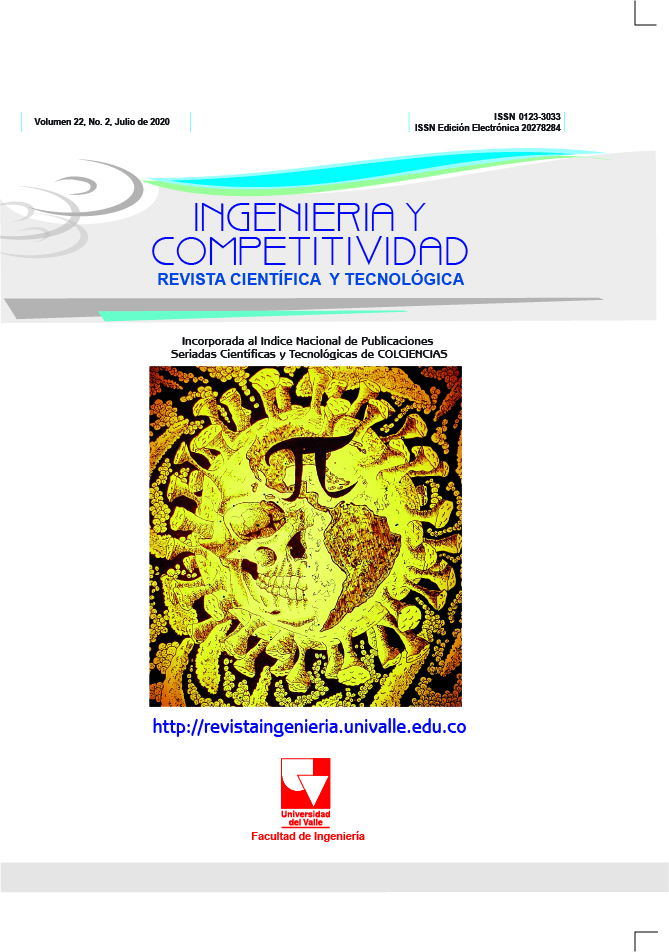Luminiscencia a baja temperatura en fósforos puros de ZnO
Contenido principal del artículo
En este estudio se prepararon muestras de ZnO puro a través de reacción química en estado sólido y se investigó las propiedades ópticas del material a bajas temperaturas. Se encontró que la banda ancha de emisión se corrió hacia el azul con el incremento de la temperatura. Esto es atribuido tentativamente al cambio del campo eléctrico local de los dipolos eléctricos, la orientación de los cuales es sensitiva a la temperatura. Las estrechas líneas en el ultravioleta observadas a bajas temperaturas son asignadas a excitones ligados y sus réplicas de fonones.
- Excitones
- Fonones
- Fotoluminiscencia (FL)
- ZnO
(1) Dorlanne O, Ai B, Destruel P, Lobiere A. Electrical characteristics of zinc oxide varistrs subjected to hydrostatic pressure. J Appl. Phys. 1985; 57:5535. Doi: 10.1063/1.334834.
(2) Dayan N J, Sainkar S R, Karekar R N, Aiyer R C. Forulation and characterization of ZnO:Sb thick-film gas sensors. Thin Solid Films. 1998; 325(1-2):254-258. Doi: 10.1016/S0040-6090(98)00501-X.
(3) Mitra P, Chatterjee A P, Maiti H S, Chemical deposition of ZnO films for gas sensors. J Mater Sci: Mater Electron. 1998; 9(6):441-445. Doi: 10.1023/A:1008993706957.
(4) Tang Z K, Wong G K L, Yu P, Kawasaki M, Ohtomo A, Koinuma H, Segawa Y. Room-temperature ultraviolet laser emission from self-assembled ZnO microcrystallite thin films. Appl Phys. Lett. 1998; 72:3270. Doi: 10.1063/1.121620.
(5) Reynolds D C, Look D C, Jogai B. Optically pumped ultraviolet lasing from ZnO. Solid State Commun. 1996; 99(12):873-875. Doi: 10.1016/0038-1098(96)00340-7.
(6) Jia W, Monge K, Fernández F. Energy transfer from the host to Eu3+ in ZnO. Optical Materials. 2003; 23(1-2):27-32. Doi: 10.1016/S0925-3467(03)00054-5.
(7) Dingle R. Luminescent transitions associates with divalent copper impurities and the green emission from semiconducting zinc oxide. Phys Rev Lett. 1969; 23:579. Doi: 10.1103/PhysRevLett.23.579.
(8) Anpo M, Kubokawa Y. Photoluminescence of zinc oxide powder as a probe of electron-hole surface processes. J. Phys. Chem. 1984; 88(23):5556-5560. Doi: 10.1021/j150667a019.
(9) Vanheusden K, Warren W L, Seager C H, Tallan D R, Voigt J A, Gnade B E. Mechanisms behind green photoluminescence in ZnO phosphor powder. J Appl Phys. 1996; 79(10):7983. Doi: 10.1063/1.362349.
(10) Vvan Dijken A, Meulenkamp E A, Vanmaekelbergh D, Meijerink A. The kinetics of the radiative and nonradiative processes in nanocrystalline ZnO particles upon photoexcitation. J Phys Chem B. 2000; 104(8), 1715-1723. Doi: 10.1021/jp993327z.
(11) Jia W, Sol-gel method for preparation of phosphors, in Inorganic Phosphors, Yen W M and Weber M J (eds.), CRC Press, Boca Raton, FL; 2004. p336.
(12) Jia W, Monge K, Xu W, Katiyar R. Spectroscopy of pure and Eu3+ doped ZnO. Integrated Ferroelectrics. 2002. 42(1):357-363. Doi: 10.1080/10584580210836.
(13) Yen WM, Weber MJ. Inorganic Phosphors Compositions, Preparation and Optical Properties. 1st Ed. Boca Raton: CRC Press; 2004.
(14) Kasai P H. Electron spin resonance studies of donors and acceptors in ZnO. Phys Rev.1963; 130(3):989. Doi: 10.1103/PhysRev.130.989.
(15) Kanhenschen K, Seager C H, Warren W L, Tallan D R, Voigt J A. Correlation between photoluminescence and oxygen vacancies in ZnO phosphors. Appl Phys Lett. 1996; 68(3):403-405. Doi: 10.1063/1.116699.
(16) Bylander E G. Surface effects on the lowenergy cathodoluminescence of zinc oxide. J Appl Phys. 1978; 49:1188. Doi: 10.1063/1.325059.
(17) Van Dijken, Meulenkamp E A, Vanmaekelbergh D, Meijerink A. Identification of the transition responsible for the visible emission in ZnO using quantum size effects. J Lumin. 2000; 90(1-3): 123-128. Doi: 10.1016/S0022-2313(99)00599-2.
(18) Van Dijken A, Meulenkamp E A, Vanmaekelbergh D, Meijerink A. The luminescence of nanocrystalline ZnO particles: the mechanism of the ultraviolet and visible emission. J Lumin. 2000; 87-89: 454-456. Doi: 10.1016/S0022-2313(99)00482-2.
(19) Van Dijken A, Makkinje J, Meijerink A. The influence of particle size on the luminescence quantum efficiency of nanocrystalline ZnO particles. J Lumin [Internet]. 2001. 92(4):323-328. Doi: 10.1016/S0022-2313(00)00262-3.
(20) Yen WM, Shionoya S, Yamamoto H, editors. Luminescence of localized center. In: Phosphor Handbook. 2nd Ed. Boca Raton: CRC Press; 2006.
Descargas

Esta obra está bajo una licencia internacional Creative Commons Atribución-NoComercial-CompartirIgual 4.0.
Los autores que publican en esta revista están de acuerdo con los siguientes términos:
Los autores ceden los derechos patrimoniales a la revista y a la Universidad del Valle sobre los manuscritos aceptados, pero podrán hacer los reusos que consideren pertinentes por motivos profesionales, educativos, académicos o científicos, de acuerdo con los términos de la licencia que otorga la revista a todos sus artículos.
Los artículos serán publicados bajo la licencia Creative Commons 4.0 BY-NC-SA (de atribución, no comercial, sin obras derivadas).





